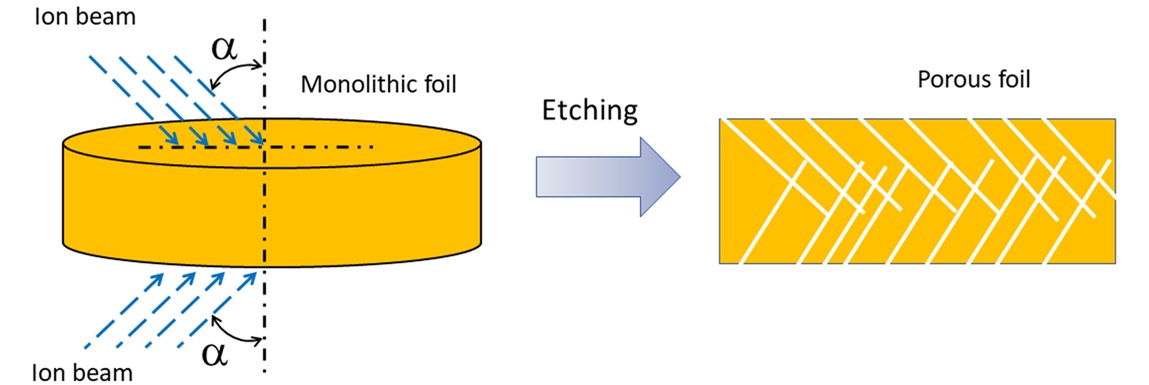A New Application of Track-Etched Membranes in X-Ray and Vacuum Ultraviolet Optics
DOI:
https://doi.org/10.31489/2959-0663/3-25-4Keywords:
accelerated ions, track-etched membranes, pore channels, X-ray optics, solar astronomy, air inlet/outlet, stray optical radiation, thin-film X-ray filters, solar X-ray radiometersAbstract
Due to their unique structure properties, track-etched membranes are widely used in scientific and engineering practice to solve specific tasks and perform certain functions. Typical examples are diffraction filters, supports for thin-film X-ray filters and collimators in solar X-ray radiometers. In this paper new non-trivial application of track-etched membranes in optical instruments exploited in vacuum is suggested. Metal-coated track-etched membranes with modified architecture of pore channels can be used as air inlet/outlet elements that block the stray optical radiation within the inner space of the instruments. The membrane consists of two arrays of opaque channels intersecting at a certain angle inside its volume. Both surfaces are coated with light-absorbing and reflective layers of aluminum, which allows background optical radiation to be suppressed by several orders of magnitude. Residual air can pass through the membrane, which reduces the mechanical load on the sensitive elements of the device during fluctuations in external pressure. The developed “black” membranes are promising for use in various X-ray optical devices, including those for space purposes.
References
Fischer, B.E., & Spohr, R. (1983). Production and use of nuclear tracks: imprinting structure on solids. Rev. Mod. Phys., 55, 907–948. https://doi.org/10.1103/RevModPhys.55.907 DOI: https://doi.org/10.1103/RevModPhys.55.907
Apel, P. (2003). Swift heavy ion effects in polymers: Industrial applications. Nucl. Instrum. Meth. in Phys. Res., Section B, 208, 11–20. https://doi.org/10.1016/S0168-583X(03)00634-7 DOI: https://doi.org/10.1016/S0168-583X(03)00634-7
Mitrofanov, A. V., Apel, P. Y., Ivanov, O. M., Nazmov, V. P., & Pudonin, F. A. (2010). Light traps based on micro- and nanostructures. In X-Ray Optics–2010: Proceedings of the Conference (Chernogolovka, Russia, September 20–23, 2010, pp. 145–146) [in Russian].
Malek, C. K., & Saile, V. (2004). Applications of LIGA technology to precision manufacturing of high-aspect-ratio micro-components and -systems: a review. Microelectronics Journal, 35(2), 131–143. https://doi.org/10.1016/j.mejo.2003.10.003 DOI: https://doi.org/10.1016/j.mejo.2003.10.003
Menz, W., Mohr, J., & Paul, O. (2001). Microsystem technology. Wiley-VCH. DOI: https://doi.org/10.1002/9783527613007
Flerov, G. N., & Barashenkov, V. S. (1975). Practical applications of heavy ion beams. Soviet Physics Uspekhi, 17(5), 783–793. https://doi.org/10.1070/pu1975v017n05abeh004371 DOI: https://doi.org/10.1070/PU1975v017n05ABEH004371
Flerov, G. N., Kuznetsov, V. I., Verkin, B. I., Mikhalchenko, R. S., & Pershin, N. P. (1982). Thermophysical and gas-dynamic properties of screen-vacuum thermal insulations on the basis of polynuclear filters. In Proceedings of the 4th Meeting on the Application of Novel Nuclear Physics Methods for Solving Scientific, Technical and National Economic Tasks (JINR Communi-cation P18-82-117, pp. 150–153). Dubna: Joint Institute for Nuclear Research [in Russian].
Gikal, B. N., Dmitriev, S. N., Gul’bekyan, G. G., Apel’, P. Yu., Bashevoi, V. V., Bogomolov, S. L., Borisov, O. N., Buzma-kov, V. A., Ivanenko, I. A., Ivanov, O. M., Kazarinov, N. Yu., Kolesov, I. V., Mironov, V. I., Papash, A. I., Pashchenko, S. V., Sku-ratov, V. A., Tikhomirov, A. V., Khabarov, M. V., Cherevatenko, A. P., & Yazvitskii, N. Yu. (2008). IC-100 accelerator complex for scientific and applied research. Physics of Particles and Nuclei Letters, 5(1), 33–48. https://doi.org/10.1134/s1547477108010068 DOI: https://doi.org/10.1134/S1547477108010068
Biersack, J. P., & Ziegler, J. F. (1982). The Stopping and Range of Ions in Solids. Ion Implantation Techniques, 122–156. https://doi.org/10.1007/978-3-642-68779-2_5 Free SRIM software is available from the website: http://www.srim.org DOI: https://doi.org/10.1007/978-3-642-68779-2_5
Blonskaya, I. V., Kirilkin, N. S., Kristavchuk, O. V., Lizunov, N. E., Mityukhin, S. A., Orelovich, O. L., Polezhaeva, O. A., & Apel, P. Y. (2023). Visualization and characterization of ion latent tracks in semicrystalline polymers by FESEM. Nuclear In-struments and Methods in Physics Research Section B: Beam Interactions with Materials and Atoms, 542, 66–73. https://doi.org/10.1016/j.nimb.2023.06.009 DOI: https://doi.org/10.1016/j.nimb.2023.06.009
Apel, P. Y. (2025). Intersections of pore channels in track-etched polymer templates and membranes. Materials Chemistry and Physics, 339, 130681. https://doi.org/10.1016/j.matchemphys.2025.130681 DOI: https://doi.org/10.1016/j.matchemphys.2025.130681
Mitrofanov, A. V., & Apel, P. Yu. (2009). X-ray diffraction filters based on track membranes. Bulletin of the Russian Acad-emy of Sciences: Physics, 73(1), 57–61. https://doi.org/10.3103/s106287380901016x DOI: https://doi.org/10.3103/S106287380901016X
More-Chevalier, J., Novotný, M., Hruška, P., Fekete, L., Fitl, P., Bulíř, J., Pokorný, P., Volfová, L., Havlová, Š., Vondráček, M., & Lančok, J. (2020). Fabrication of black aluminium thin films by magnetron sputtering. RSC Advances, 10(35), 20765–20771. https://doi.org/10.1039/d0ra00866d DOI: https://doi.org/10.1039/D0RA00866D
Mitrofanov, A. V., Apel, P. Yu., Blonskaya, I. V., & Orelovitch, O. L. (2006). Diffraction filters based on polyimide and poly(ethylene naphthalate) track membranes. Technical Physics, 51(9). https://doi.org/10.1134/s1063784206090209 DOI: https://doi.org/10.1134/S1063784206090209
Kravets, V. G., Schedin, F., & Grigorenko, A. N. (2009). Almost Complete Absorption of Light in Nanostructured Metallic Coatings: Blackbody Behavior. PIERS Online, 5(4), 397–400. https://doi.org/10.2529/piers090219104337 DOI: https://doi.org/10.2529/PIERS090219104337
Mitrofanov, A.V., Feshchenko, R.M. (2023). On the numerical modeling of track-etched membranes used as collimators of the X-ray radiation. Zhurnal Tekhnicheskoy Fiziki, 93(7), 948–952. https://doi.org/10.21883/jtf.2023.07.55751.55-23 DOI: https://doi.org/10.21883/JTF.2023.07.55751.55-23

Downloads
Published
How to Cite
Issue
Section
License
Copyright (c) 2024 Alexandr V. Mitrofanov, Pavel Yu. Apel, Oleg M. Ivanov, Fedor A. Pudonin

This work is licensed under a Creative Commons Attribution-NonCommercial-NoDerivatives 4.0 International License.
This work is licensed under a Creative Commons Attribution-NonCommercial-NoDerivatives 4.0 International License.
Authors retain copyright and grant the journal right of first publication with the work simultaneously licensed under a Creative Commons Attribution License (CC BY-NC-ND 4.0) that allows others to share the work with an acknowledgement of the work's authorship and initial publication in this journal.



